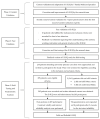Adaptation and Psychometric Validation of the EMPOWER-SUSTAIN Usability Questionnaire (E-SUQ) among Patients with Metabolic Syndrome in Primary Care
- PMID: 34502011
- PMCID: PMC8431134
- DOI: 10.3390/ijerph18179405
Adaptation and Psychometric Validation of the EMPOWER-SUSTAIN Usability Questionnaire (E-SUQ) among Patients with Metabolic Syndrome in Primary Care
Abstract
Self-management support is one of the most important components of the Chronic Care Model (CCM). The EMPOWER-SUSTAIN Global Cardiovascular Risks Self-Management Booklet© was developed for patients with Metabolic Syndrome (MetS), inspired by the CCM. Assessing usability of a self-management tool is important in chronic disease management. However, there was no available instrument to assess usability of a self-management booklet, as most instruments were developed to assess usability of mobile application. Therefore, this study aimed to adapt Skala Kebolehgunaan Aplikasi Mudah Alih (SKAMA) into the EMPOWER-SUSTAIN Usability Questionnaire (E-SUQ) and to determine its validity and reliability in assessing usability of a self-management booklet. A cross-sectional validation study was conducted among patients with MetS attending a university primary care clinic in Selangor, Malaysia. Content validation, adaptation and face validation of E-SUQ were performed according to recommended guidelines. It underwent two rounds of content validation as major revision was required for item 5. Subsequently, the revised E-SUQ was face-validated by 10 participants. Psychometric evaluation was conducted using principal component analysis with varimax rotation to determine the underlying structure of E-SUQ. Internal consistency reliability was assessed using Cronbach's α coefficient and the test-retest reliability was assessed using intraclass correlation coefficient (ICC (2,k)). A total of 205 patients participated in the study. The item-level content-validity-index (I-CVI) for item 5 improved from 0.57 to 1.0 after the second round of content validation. The final S-CVI/Ave value for ESUQ was >0.90. The item-level face-validity-index (I-FVI) ranged between 0.9 and 1.0. Kaiser-Meyer-Olkin value of 0.871 and Bartlett's test of sphericity p-value of <0.05 indicated good sample adequacy for factor analysis. Two factors with eigenvalues of >1 were extracted according to the Kaiser's Criteria. The two extracted factors explained 60.6% of the cumulative percentage of variance. The elbow of the scree plot occurred between the second and third component, suggesting two factors to be retained. The two factors were consistent with "Positive" and "Negative" tone model. The overall Cronbach's α coefficient was 0.77, indicating good internal reliability. The overall ICC was 0.85, indicating good reproducibility. The E-SUQ is shown to be valid, reliable and stable to measure the usability of a self-management booklet among patients with MetS in a university primary care clinic in Malaysia.
Keywords: Malay language; chronic care model; questionnaire validation; self-management; usability.
Conflict of interest statement
The authors declare no conflict of interest.
Similar articles
-
Factors associated with usability of the EMPOWER-SUSTAIN Global Cardiovascular Risks Self-Management Booklet© among individuals with metabolic syndrome in primary care: a cross-sectional study.BMC Prim Care. 2024 Feb 3;25(1):51. doi: 10.1186/s12875-024-02281-z. BMC Prim Care. 2024. PMID: 38310212 Free PMC article.
-
Validity and reliability of the Patient Activation Measure® (PAM®)-13 Malay version among patients with Metabolic Syndrome in primary care.Malays Fam Physician. 2020 Nov 10;15(3):22-34. eCollection 2020. Malays Fam Physician. 2020. PMID: 33329860 Free PMC article.
-
Development and Validation of a Malay Version Questionnaire to Evaluate Remote Health Monitoring of COVID-19 via Telehealth Applications: Navigating Telehealth Evolution.Cureus. 2024 Aug 23;16(8):e67579. doi: 10.7759/cureus.67579. eCollection 2024 Aug. Cureus. 2024. PMID: 39310655 Free PMC article.
-
An adapted management of early warning signs of relapse questionnaire: Validity and reliability.Arch Psychiatr Nurs. 2023 Aug;45:16-25. doi: 10.1016/j.apnu.2023.04.015. Epub 2023 May 9. Arch Psychiatr Nurs. 2023. PMID: 37544693 Review.
-
Development and validation of an instrument to measure pediatric nurses' adherence to ethical codes.BMC Med Ethics. 2022 Feb 25;23(1):14. doi: 10.1186/s12910-022-00753-4. BMC Med Ethics. 2022. PMID: 35216609 Free PMC article. Review.
Cited by
-
Factors associated with usability of the EMPOWER-SUSTAIN Global Cardiovascular Risks Self-Management Booklet© among individuals with metabolic syndrome in primary care: a cross-sectional study.BMC Prim Care. 2024 Feb 3;25(1):51. doi: 10.1186/s12875-024-02281-z. BMC Prim Care. 2024. PMID: 38310212 Free PMC article.
References
-
- World Health Organization . Global Status Report on Noncommunicable Diseases 2014. WHO; Geneva, Switzerland: 2014. [(accessed on 29 June 2020)]. Available online: http://www.who.int/nmh/publications/ncd-status-report-2014/en/
-
- Alberti K.G.M.M., Eckel R.H., Grundy S.M., Zimmet P.Z., Cleeman J.I., Donato K.A., Fruchart J.C., James W.P., Loria C.M., Smith S.C., Jr. Harmonizing the metabolic syndrome: A joint interim statement of the international diabetes federation task force on epidemiology and prevention; National heart, lung, and blood institute; American heart association; World heart federation; International. Am. Hear Assoc. J. 2009;120:1640–1645. - PubMed
-
- Gami A.S., Witt B.J., Howard D.E., Erwin P.J., Gami L.A., Somers V.K., Montori V.M. Metabolic Syndrome and Risk of Incident Cardiovascular Events and Death. A Systematic Review and Meta-Analysis of Longitudinal Studies. J. Am. Coll. Cardiol. 2007;49:403–414. doi: 10.1016/j.jacc.2006.09.032. - DOI - PubMed
-
- Ramli A.S., Daher A.M., Nor-Ashikin M.N., Mat-Nasir N., Ng K.K., Miskan M., Ambigga K.S., Ariffin F., Mazapuspavina M.Y., Abdul-Razak S., et al. JIS definition identified more malaysian adults with metabolic syndrome compared to the NCEP-ATP III and IDF criteria. BioMed Res. Int. 2013;2013:1–10. doi: 10.1155/2013/760963. - DOI - PMC - PubMed
Publication types
MeSH terms
LinkOut - more resources
Full Text Sources
Medical


